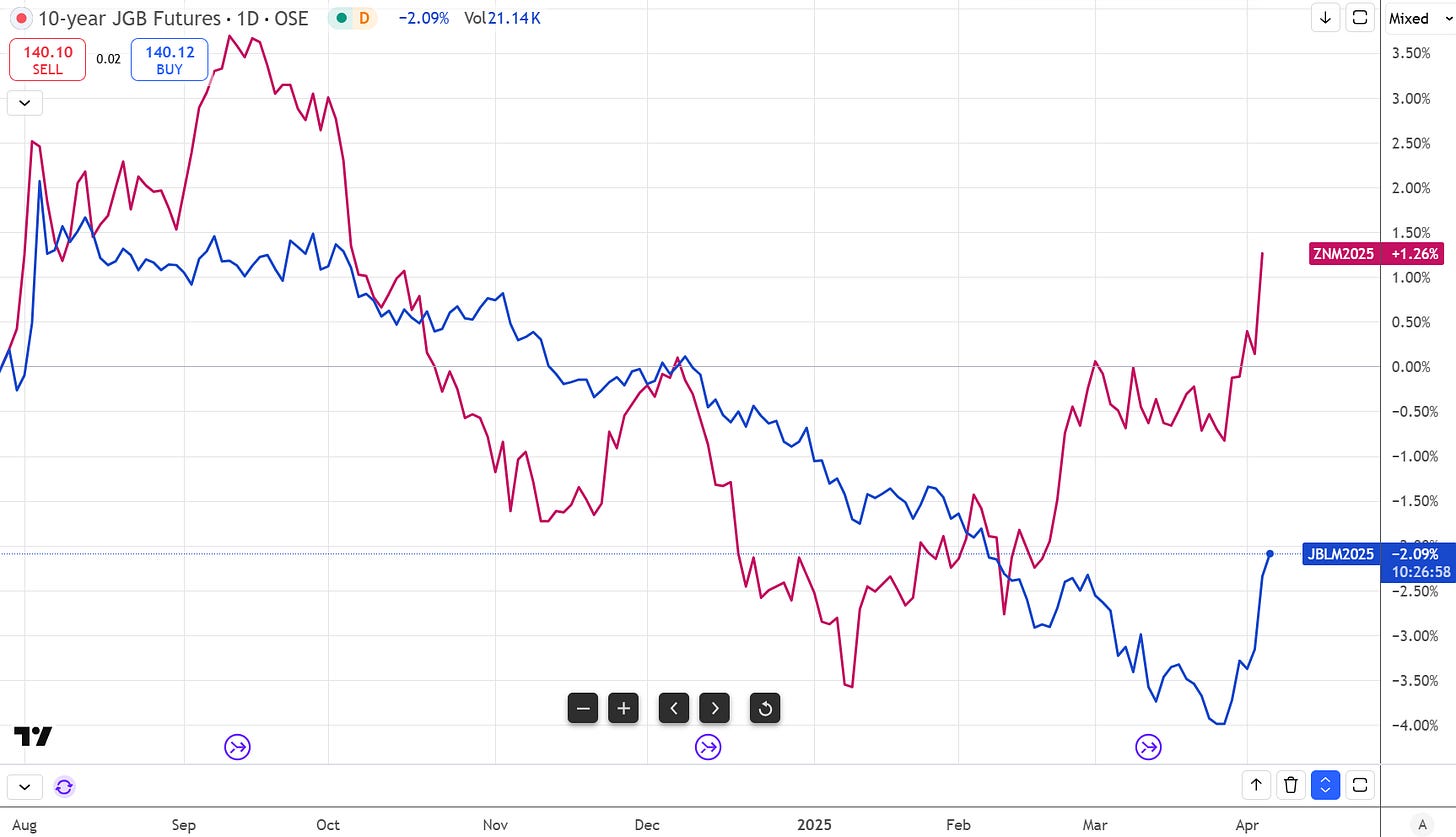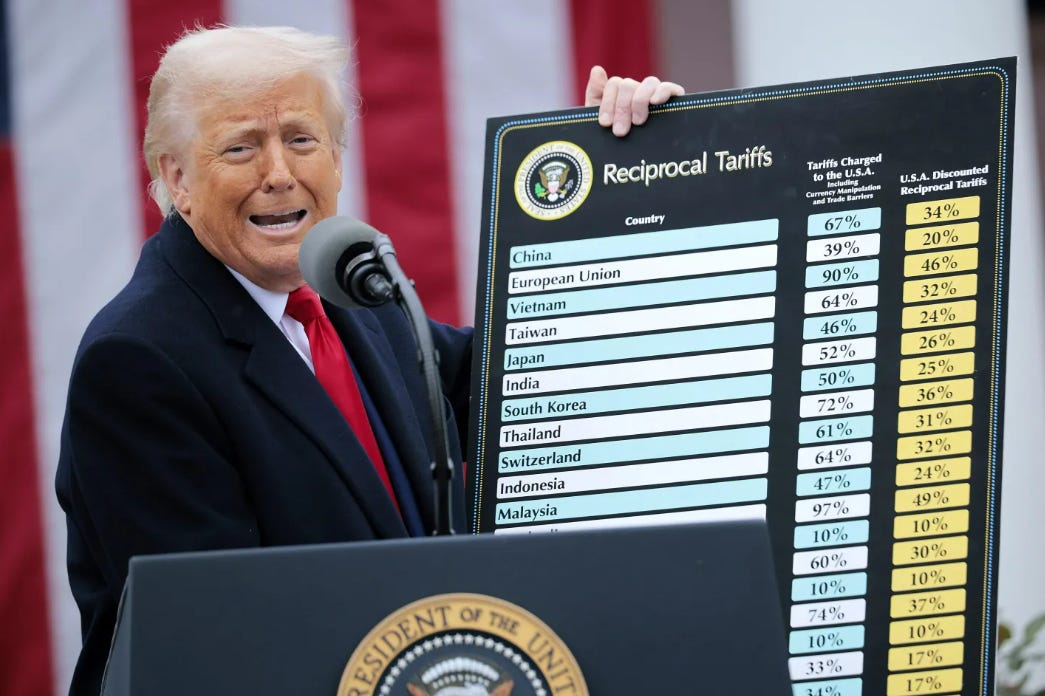
Most of you are aware of yesterday’s tariff announcements made by Trump, so I won’t recap what was announced, except for highlighting the fact that they were worse than the worst case outcome most analysts predicted. I’ve been warning about this scenario for months, and Trump exceeded even my own bearish predictions.
The country-by-country tariff rates were not even based on reciprocity (the tariffs and VAT taxes that those countries charge on US goods). Instead they were based on the size of each individual country’s trade deficit with the US relative to its GDP. This is important for several reasons:
The tariffed countries can’t negotiate away the tariffs as there is nothing to negotiate. If they were based on reciprocity, then the tariffed countries could theoretically lower all tariffs and taxes on US goods and the US would reciprocate by lowering its tariffs on that country. Unfortunately that is not that case, which suggests that these tariffs are to stay.
The tariffs were clearly designed to lower America’s trade deficit with the rest of the world. This means fewer US dollars flowing to foreign countries, and less of a need for foreign central banks and corporate treasuries to invest in US assets. The tariffs will reverse the flow of investment dollars flowing into US assets, which is bad news for US stocks and bonds.
Prior to Liberation Day, we thought that Trump would impose tariffs only on its largest trading partners, such as China, Canada, Mexico, and Europe. Instead he has imposed tariffs on every single one of its trading partners. This will create chaos in supply chains, paralyze corporate decision making, and create an inflationary supply shock.
Trump claims that his tariffs will be good for the economy in the long run, as it will result in factories getting built in the US and bring back manufacturing jobs. How great would it be if American companies and factories can make all the stuff that Americans consume? Unfortunately Trump’s plans for the economy will not play out as expected, for several reasons.
Reshoring manufacturing from abroad to the US is a multi-year investment that requires hundreds of millions, if not billions of dollars of investment. Companies need to have certainty that tariffs are here to stay. The four year election cycle and Trump’s unpredictable tariff policy make it difficult for companies to commit to reshoring their manufacturing.
Companies importing goods into the US are already seeing their equity values taking a hit, their borrowing costs rising, and their cash flow getting tight. They are not in a great financial position to be making big investments into reshoring their manufacturing into the US.
Manufacturing in the US is very different from manufacturing in China, Vietnam, and Bangladesh. Labor laws, unions, and regulations make it more expensive and slow to make stuff in the US than in other countries (with good reason - labor conditions in those countries are horrible). Trump and Musk can do everything they can to reduce regulation but companies will not be able to make things as fast and cheap as they do in China.
The US dollar endgame
Over the past decade, America’s politicians have been making unforced error after unforced error to bring it to the brink of losing its status as the world’s dominant power with the global reserve currency. It’s almost as if they are following a playbook that lays out exactly how to lose their global reserve currency status as quickly as possible:
Destroy the value of the US dollar by printing as much of it as possible (Jerome Powell, 2020-21).
Run up the debt/GDP ratio by borrowing as much as possible in an economic expansion, with little to no long-term economic benefit (Trump 2017, Biden, 2020-22).
Tear up all military and diplomatic alliances with America’s long term allies (Trump 2025).
Stop buying goods from the rest of the world, discouraging the need for foreigners to hold US dollars and US assets (Trump 2025).
Accelerate foreign divestment of US assets by deliberately tanking the economy (Trump 2025).
Undermine the world’s faith in the soundness and stability of America’s legal and political system (Trump 2025)
Undermine the world’s faith in America as an open economy and free capital market (Trump 2025)
We are currently in uncharted territory, with Trump running an economic and geopolitical experiment on the largest scale possible. There are a lot of ways it can go wrong, and only a few ways it can go right. If things go right, this is what it would look like:
Trump has publicly declared his intention to pass corporate tax cuts, but this was always a long shot due to the already-large budget deficit. Unfolding weakness in the markets and economy finally scare Congress into approving a sweeping tax cut bill. With tariffs weighing on the economy but bringing $500-800B in tax revenue at the same time, Congress plays the hand it was dealt by Trump and saves the economy by approving corporate tax cuts and other stimulative measures.
Scott Bessent gets Treasury yields near his desired 3% level, which loosens financial conditions enough for the economy to recover and for US manufacturers to invest in reshoring. The relief rally in JGBs has spilled into US Treasuries and allowed Treasuries to react more freely to the risk-off environment.

Blue - 10 yr JGB futures. Purple - 10 yr Treasury futures. The recent rally in JGBs and selloff in equities has helped Treasuries rally to 4.05% in yield Unfortunately we are still 100 bp away from 3%, and it would take significantly more pain in the markets and economy to cover that distance. The Fed has expressed reluctance to cut rates due to underlying inflationary pressures, which would be exacerbated by tariffs. There is only one 25 bp hike priced into the market between now and June - not enough to provide relief for the market.
Between tariffs ($500-800B in additional revenue), corporate tax cuts ($150B less revenue), and DOGE ($140B less spending and counting), Trump manages to get the budget deficit down to 4-5%. Bessent refinances a lot of the Treasury’s debt by issuing a lot of long term notes at 3%, while the economy rebalances by providing private sector employment for the government workers who have lost their jobs. After a painful 1-2 years, Trump reduces existing tariffs, which provides relief for the economy and stock market. Productivity remains above 3% for a while, buoyed by fewer regulations, a smaller government, and corporate tax cuts, igniting a new multi-year bull market.
This bullish scenario is a narrow path, and a lot of things have to go right, such as Trump maintaining his approval rating, Congress passing corporate tax cuts, the Fed cutting rates, and Musk keeping his job as head of DOGE.
Update on current views and positions
I’ve been bearish on US equities since February and remain short. Even the long-term bullish scenarios I mentioned above require short term pain for the market and economy. On March 28 I posted in the paid subscriber chat that the bounce in risk was likely to end and that we would likely start another leg down.
I am much more active when it comes to trading SPX futures so it’s impossible for me to update readers on each and every trade in real time. I inform traders about my medium-term directional bias - bullish, neutral, or bearish. Since turning bearish and shorting the first leg down from 5730 to 5550, I covered and then resold during Trump’s Rose Garden speech yesterday. I managed to find some wifi at the ski resort while on vacation and watched the speech live on my phone with my trading app simultaneously open. When Trump brought out the tariff chart, I had to pinch out to zoom in on the picture, and the numbers on the right hand column told me to short SPX futures in full size.
I’m still short going into tomorrow’s US employment number. Yesterday’s ISM services employment number came in at a very weak 46.2, which suggests that we may see a weak NFP print either this month or next month. The soft data has been coming in weak, and the market is now bracing for the hard data to follow in its footsteps.
The VIX closed above 30 today, the zone where forced deleveraging takes place. Things are getting hairy so I’m not providing any downside targets for now, as it’s anyone’s guess where this market will bottom out.
More on rates, crypto, FX, and gold behind the paywall…
Keep reading with a 7-day free trial
Subscribe to Fidenza Macro to keep reading this post and get 7 days of free access to the full post archives.





